
There was a wonderful flute paper published in the eighties by Anne McFarland called The Flute Worker. I was lucky enough to write some technical articles for it, which I will include here as time and space permit.
*****************************************************
from Flute Worker
May, 1983
Copyright, Eldred Spell
The past few years have seen a general consciousness rising among flute players regarding the function of the headjoint. It used to be that the body and head were considered a sacred unit, to be separated only at the risk of divine wrath. If you had a flute and didn't like the sound, you sold the complete instrument and bought another. For obvious reasons most flutists learned to accept whatever they got, without criticism or serious evaluation. It's not difficult to see how a basic design (arrived at in the 1860's) remained essentially unchanged for nearly a century.
Today's flutists have come to realize what other wind and string players have known all along, that an instrument is no better than its mouthpiece or bow.
During the past few years a number of design changes have caught on, most of them emanating from London. With the spread of these new ideas has come an increased willingness on the part of flutemakers to share information and try new ideas. Some of the mystery surrounding the design and manufacture of headjoints has been removed, at least among those actively involved.
What follows is a chart showing some of the basic parts and critical areas of a headjoint of modern design. These things are and always have been somewhat controversial. Each flutemaker has his own recipe and varies the ingredients accordingly. As a result, what one maker considers vitally important may be of no use to another. I have tried to show those aspects which are generally agreed upon or which can easily be verified empirically. At this point I must insert a warning. It is easier to ruin a headjoint than to improve one. THIS IS NOT A "HOW TO" ARTICLE ! ! !

1. The tenon should be tight enough to prevent air leaking, and yet loose enough to permit you to tune up. The fit also affects the resonance of the instrument, and people have been arguing over how and why for years. Some people say a loose fit lets the head vibrate more. Others say that a tight fit makes the whole instrument vibrate, which is supposed to be better yet.
2. The taper keeps
you from going flat in the high register. A head without any taper plays
unbelievably flat on top. The taper is added to bring the flat notes up to pitch.
In theory the notes of the second octave are most affected, but no one seems to
complain about these. If the angle of the taper is too sharp, it seems to make
the notes from high D# through G sharp. If you have this problem try a head
made on the old Louis Lot taper or Boehm taper. The Bonneville taper is even a
little flat.
3. Wall height is measured at the side of the embouchure hole. Five millimeters is standard. More than that gives an easier low register and harder high register. A lower wall gives the reverse.
4. Undercutting is done on the sides, where the embouchure hole and the head tube meet to form a sharp edge. If this edge is rounded, turbulence is reduced and you get a clearer sound. Undercutting effectively reduces the wall height and so improves the high register. It also makes the headjoint blow more freely.
5. Overcutting seems to work much like undercutting. If it is done too much, the low register suffers greatly. It should never be done to a large embouchure hole.
6. The cork assembly has a lot in common with the tenon. It must be airtight and people argue about how tight and loose it should fit and what it ought to be made of. Its position affects the taper and therefore intonation and quality of tone. If your flute seems sharp, as mentioned under taper, try setting the cork at 18 mm. or even 19 mm. instead of the customary 17 mm. Sometimes this helps and sometimes it creates more problems than it solves. In theory there is an ideal cork position for each note and you have to find the best compromise.
7. The head crown is another subject of controversy. People have been doing strange things with them for years. My best guess is that what is really important with both cork and crown is the weight. If you change the weight by as little as two grams, the playing characteristics of the instrument are affected. A lighter flute seems to blow freer and a heavier flute more resistant. (If you want to try this, just stick a clothespin anywhere on your flute, the location doesn't seem to matter.)
8. The strike wall is also known as the front wall, or the back wall depending on which side of the flute you view it from. Some people say it should be straight, others favor a gentle curve. A 7° angle is about standard. If this wall is longer or shorter it favors the low or high register respectively.
9. For a name, see number 8 above. This wall seems to arouse very little discussion or controversy. If the top is rounded it seems to give more depth to the sound, assuming the hole isn't too large to begin with.
10. The back of the lip plate should have a curvature which is comfortable under the lip. Further, if it is bent up, the effect is to aim the air more down into the hole. Bending it down effects the reverse.
11. The front of the lip plate and the strike wall form a wedge over which the airstream must pass. A narrow wedge lets air pass more freely and a wide wedge provides more resistance. This greatly affects response in the different registers and, to a lesser extent, intonation.
These descriptions barely scratch the surface of a very complex situation. In such a brief article one can only hope to heighten awareness and perhaps stimulate a little discussion.
*****************************************************
Some musings and trivia about Louis Lot flutes. Back in the mid-eighties I wrote a series of articles about restoring and (gulp) retuning Louis Lot flutes. These appeared in the "Flute Worker." Some of the info. is out of date and much has been superceded by Tula Giannini's amazing history. However, here are the articles as they originally appeared, warts and all! They appeared in installments and because of my busy schedule, I'm afraid it will be more of the same now. Here's the first:
Louis Lot Flutes Basic Facts
from THE FLUTE WORKER V.2, #2. December , 1983
By Eldred Spell
Photos by Bruce Plumer
In this and past issues Adrian Brett has detailed the development and spread of the French school of flute playing. One particular make of flute has been intimately associated with this school during the last century. As the choice of Altes, Taffanel, Hennebains and Gaubert, one might say that the Louis Lot flute has been “instrumental” in the formation of the French concept of sound.
Lot flutes have a distinct sound, and because of it, have been much sought after by a small group of players, mostly enthusiasts and exponents of the French School. Owning one is much like owning a vintage foreign car: maintenance is difficult, repairs expensive, and parts unavailable. In spite of this, there has been of late, an increase in the popularity of Louis Lot flutes among the general flute playing public.
Roughly 10,400 flutes were numbered during the ninety- seven year period of the company’s activity. These were not all created equally, so anyone contemplating the purchase of one of these instruments should be armed with information as to which flutes are considered best and what to look for. Here are a few pointers:
Engraving: The manner in which the Louis Lot name appears is about the only thing which has remained constant in the manufacture of these flutes. Figure one shows early, middle and late examples. Except in the very early flutes, the serial number appears only on the headjoint. Since headjoints could be and were easily switched, precise dating of bodies is difficult. As can be seen, the style of the markings is quite consistent. Anything which deviates from this pattern should be regarded with suspicion.
There have been several different ownerships during the life of the company and certain makers are preferred over others. The sequence of owners, dates and serial numbers are generally known, although there is some disagreement about specifics. Lyndesay G. Langwill’s Index of Musical Instrument Makers gives the following sequence: Louis Lot (1855-75), H.D. Villette (1875-1882), Debonnetbeau and E. Chambille (1882-1889). In 1889 Debonnetbeau sold his interest to M. E. Barat. E. Chambille was succeeded by his daughter who ran the company until her death in 1952. The business and mark were acquired by Strasser, Marigaux & Lemaire. As of 1960 Louis Lot flutes were being marketed by Strasser.

FIGURE 1
A popular version of the sequence of serial numbers is as follows: Louis Lot (0-2,000), Villette (2,000-3000 or 3,500), Debonnetbeau (3,000-4,600), Barat (4,600-7,400) and Chambile (7,400-10,400) All of these dates and numbers should be taken as tentative. I hope to clear up this and several other points of confusion in a future article.
Seam: Those silver flutes with numbers lower than approximately 6,000 were made by a process in which a sheet of silver was wrapped around and soldered up to form a tube. This leaves a barely visible line (see figure 2) running the length of the instrument. This is considered to be the criterion of a good Louis Lot. Many of the later seamless Lots play quite well, but they are not accorded the reverence given the older, seamed tube flutes. The sound is apparently quite different, as aficionados seem to be able to distinguish the sound of the two with ease.
D# Key: The teardrop shape (see figure 3) is characteristic of the earlier flutes, those made before 1882, although this is not entirely reliable. A teardrop D# is definitely considered preferable to the more modern designs.

FIGURE 3
Makers Marks: These are quite interesting but unfortunately they don’t mean very much. Villette began marking his flutes with two microscopically small stamps, one “H#V” and the other uncertain (see figure 4). If anyone has documentary evidence as to what the other is, I would like to know about it. Because of Vilette’s reputation, subsequent owners continued to use his stamp, destroying the value it may have had for identification. The very late seamless flutes were marked “F (see figure 5) for E. Chambille. [ Note - the mystery mark was quickly identified as a boar's head, city of Paris guarantee mark. There are several others. I'll add more photos as time allows.]
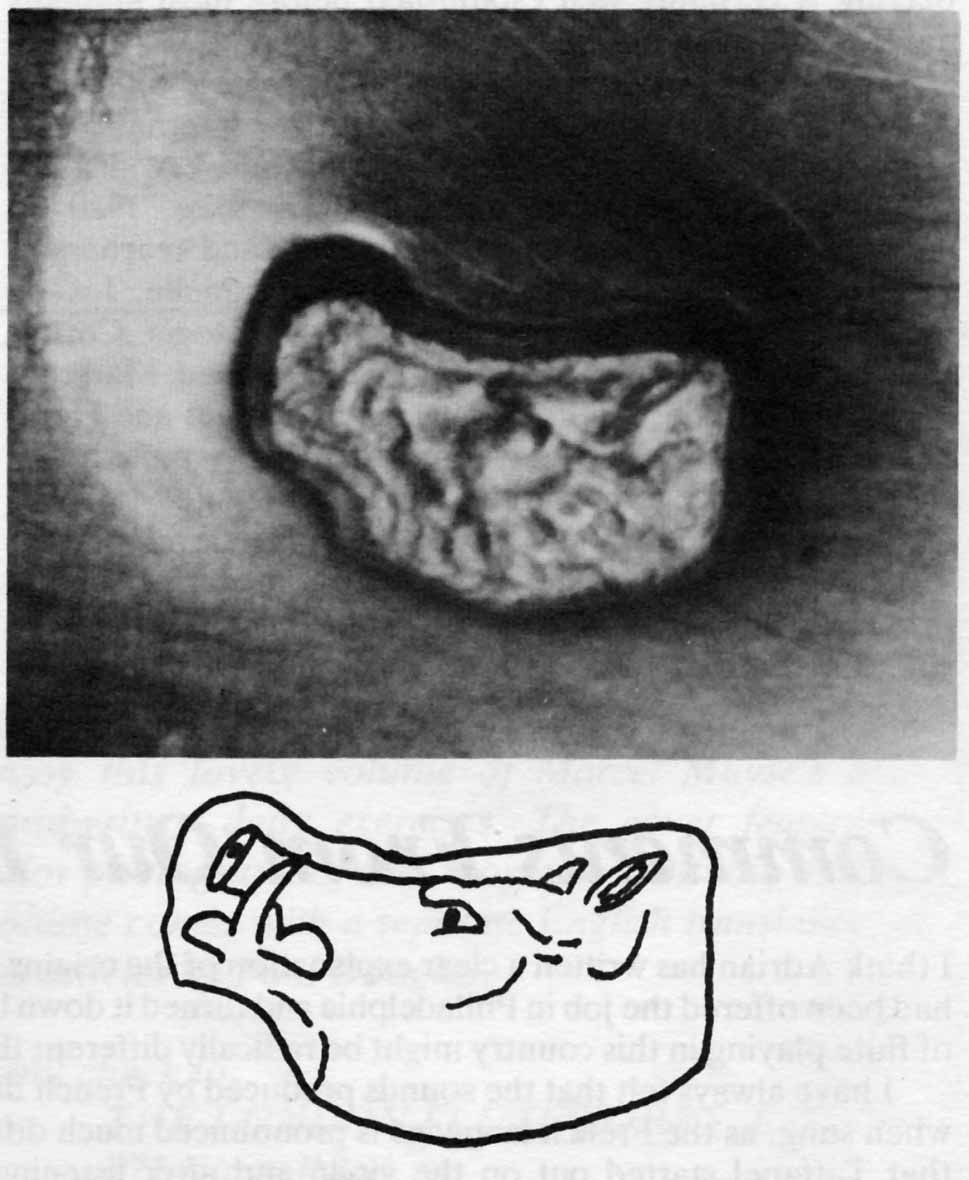

FIGURE 4

FIGURE 5
Metal: Dangle the headjoint by the crown and thump the tenon. If it goes “thunk” it is probably silver. If it rings it is probably a nickel alloy flute. These “tin” flutes are no less good than the silver ones, but one should be aware of the difference. Some players actually prefer these “tin” flutes, although this is not a majority opinion.
Sound: Unless you are looking for something to hang over the mantle, this is the bottom line. A good repairman can often work wonders with an out-of-adjustment instrument, but the sound must be there regardless. If the left hand notes are clear and the right hand fuzzy, you may just have a flute with leaky pads. On the other hand, with older instruments the solder around the tone holes is often rotten. This can be rather expensive to repair. Anyone contemplating the purchase of a Louis Lot which is not in perfect working order should be prepared to invest a substantial sum of money to set it right.
This article addresses the performer’s perspective, which is almost diametrically opposed to that of the collector. For ex ample, many believe that the unique sound comes from all the years of playing; therefore, a much played, badly worn flute is preferable to a well preserved instrument pleasing to a collector. It should be mentioned that most of the Lots heard in performance have been partially or substantially altered. Lip plates are very commonly replaced and quite a few have been retuned from the original A-435 scale to a modern one at A-440 or A-442. This is a drastic process which has been the subject of controversy.
There's been a bit of interest in this lately, so I dug out and scanned a few negatives. I've got lot's more -- if I can just find them! 'Hope these are interesting and/or helpful:

The boar's head again. I think this is the same photo as above - hopefully a better scan off the original negative. I spent the better part of a decade trying to get a recognizable picture of this little beast. Most of the impressions are either unclear or covered in dirt and tarnish. I suspect the stamps wore out quickly -- this must have been a relatively new one. With a little imagination you can see the nostril, teeth eye and ear. This particular stamp is on the lip plate of a high-pitched Lot that belonged to William Bennett.
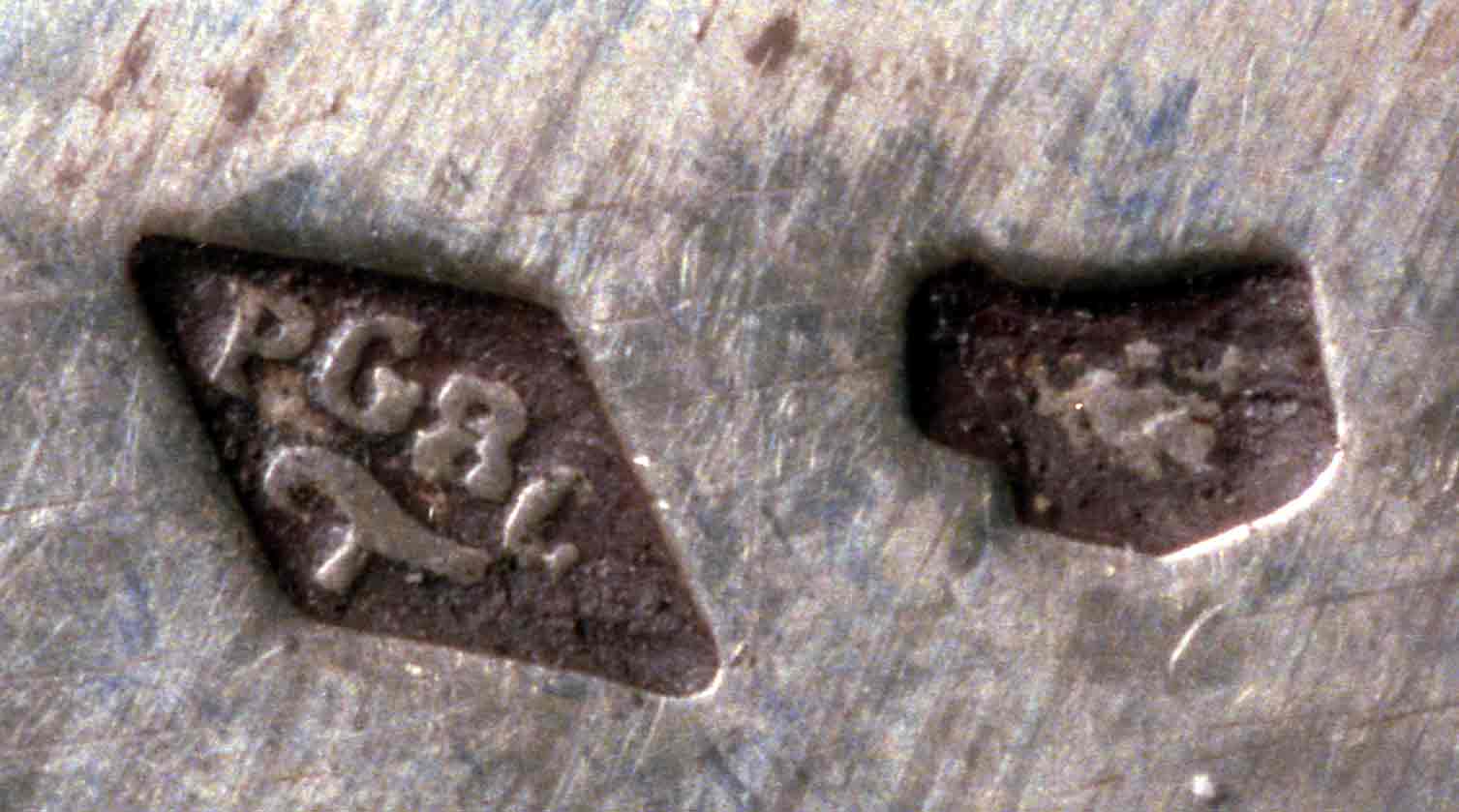
Buffet Crampon &Cie.
August Buffet is greatly under-appreciated. If not for him we might still be playing with leaf springs and vaulted clutches. If anyone has a clue about the initials, please let me know!
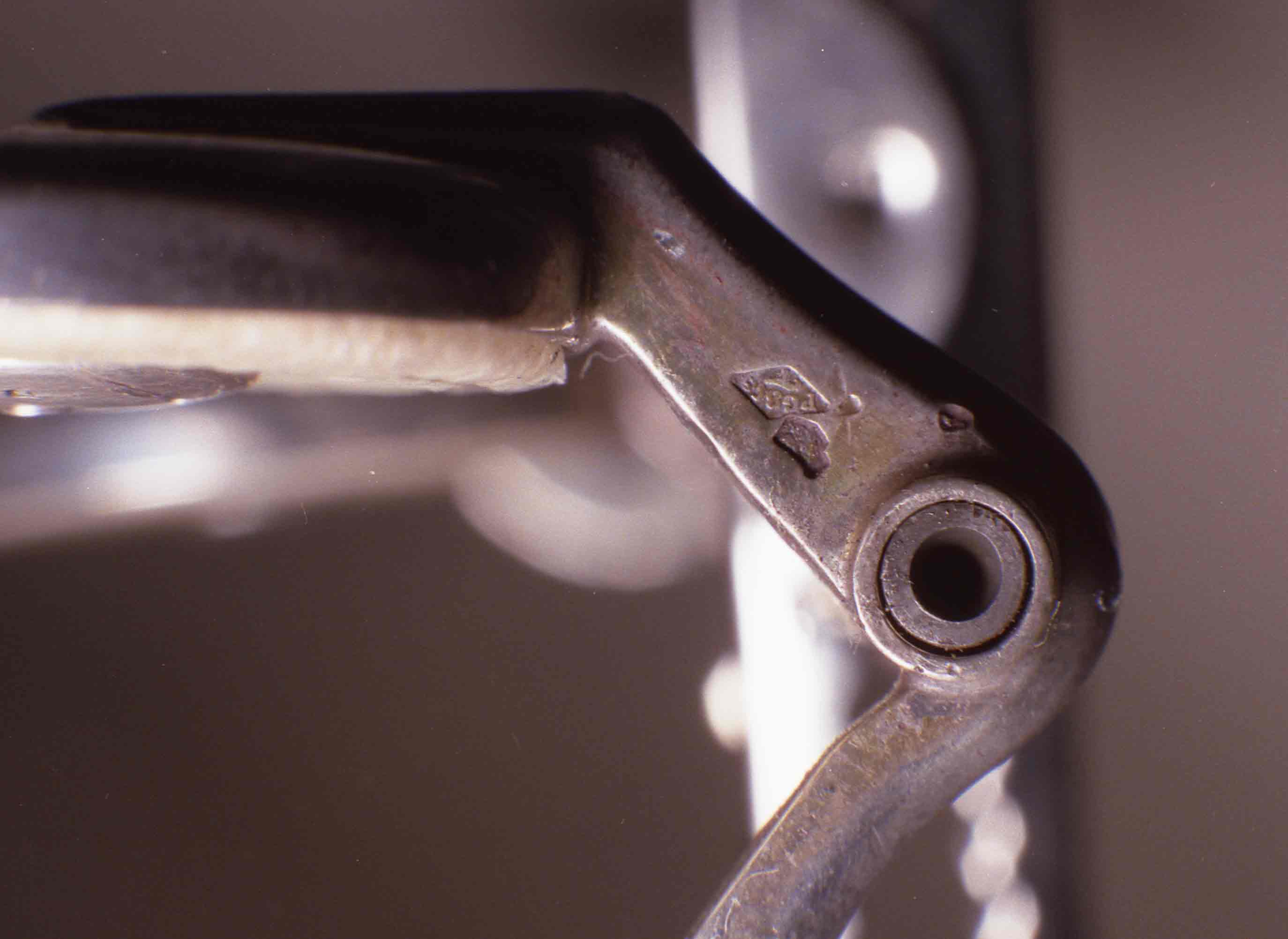
Here's another shot of Buffet marks, to give an idea of location and relative size.
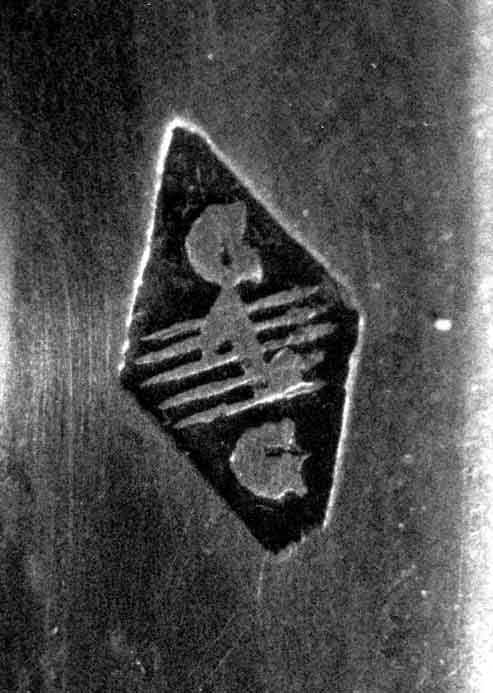
Claire Godfroy
This is from a pre-Boehm, keyed flute. The photo below shows a bad C.G. stamp with the hare (used 1819-1838, prior to the boar)

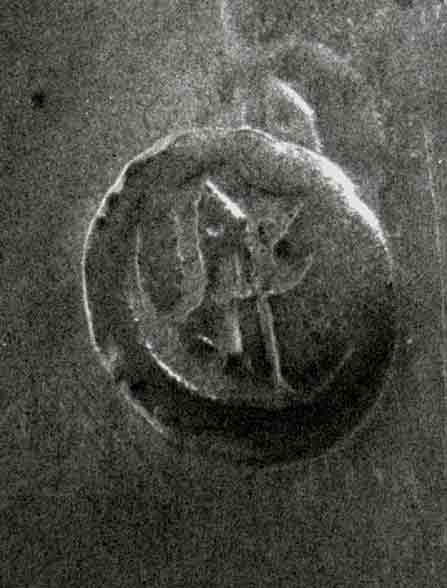
This particular flute has a third, somewhat mysterious stamp. It could be an ornate "G"
Here's some real flute
trivia:
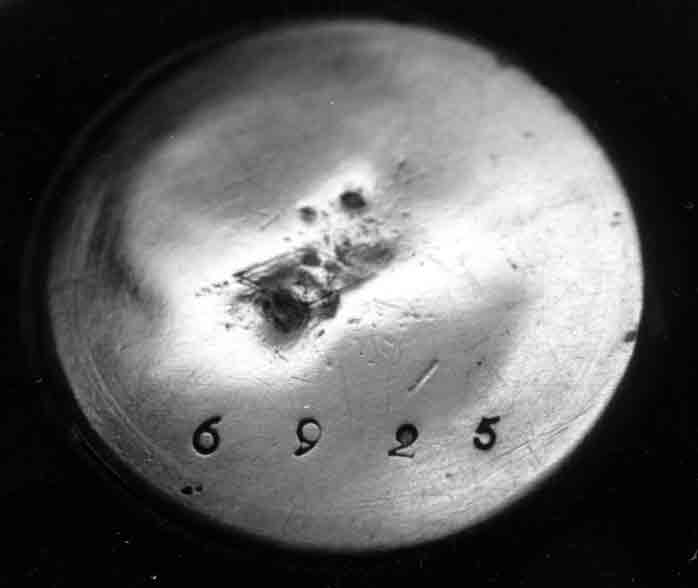
This is the cork plate from a wooden, cylinder Boehm flute by Godfroy. I have absolutely no idea what the numbers might mean. It could be the 25th flute made in 1869, but that seems a stretch.
This one belonged to Stephen Preston. He had just made some recordings on it, but was dissatisfied with the response. I messed around with it for some time before noticing an irregularity in the bore under the thumb rib. Removing the rib revealed a small, loose knot and a major air leak. Somebody at Godfroy's shop (hopefully an apprentice) had hidden the problem. A dab of epoxy made a new flute.
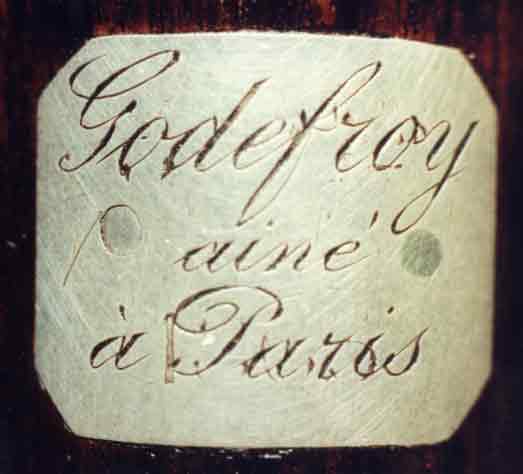
Here's the name plate from this flute.
The name is misspelled! It would be too easy to call this a fake. I would speculate that the silver name plate was riveted to the body and then turned flush with the wood. Only then would it have been sent off for engraving. When it came back, Godfroy would have had two choices: a) scrap the body and start over b) live with it. This is from an earlier cylinder Boehm flute. Below is the stamp from a late example:
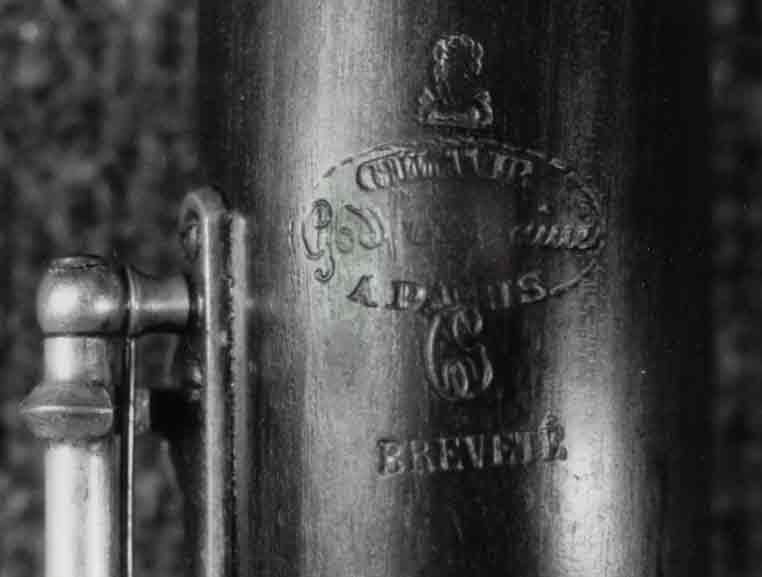
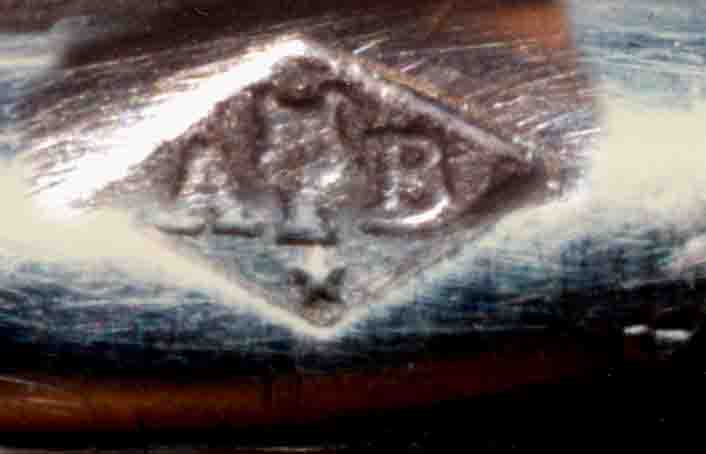
Ate Bonneville
Is is Antoine, Atelier, or what?* Bonneville is the least researched of the important French makers. Someone needs to do a dissertation.
We've had some interesting speculation about this on the Louis Lot list, with the erudite leaning towards the somewhat counterintuitive "Auguste." After all, this was the man's name.
What I really want to see is some sort of Bonneville documentation. Surely there's a piece of stationary, a sales receipt, or a printed advertisement out there somewhere.
SWAN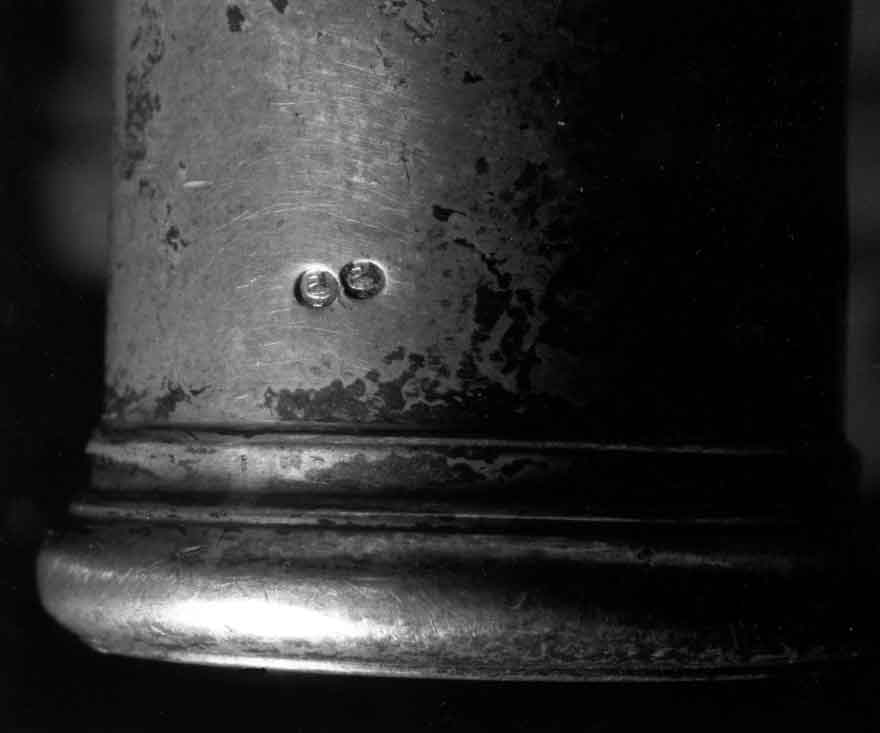
I believe this is a city of Paris import mark. In this case I would take it to mean the tube is imported. This is from a 2xxx Louis Lot. The wide shot gives a good idea of just how small (and difficult to fake) these marks are.
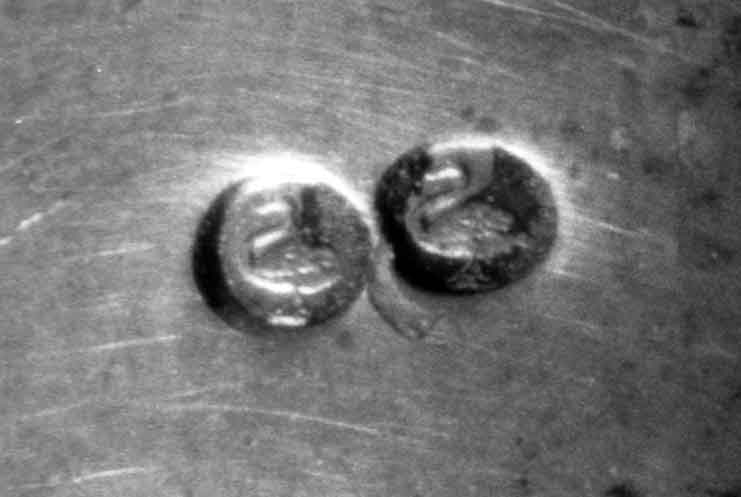
.jpg)
British Flutes:
Hill (late Monzani)
The English system of hallmarks actually tells you the date of manufacture. You do need a table to decipher the code.
Unfortunately, there are a lot of stamps involved and most British makers seem to have avoided their use.
OK - here it is - by popular demand!
We are all indebted to flutist/chemist Diane Johnson who made this possible. The chart below represents two sets of data (from 1984 and 1986), hence a few inconsistencies in the format. I also have data from XRMA analysis of the silver solder used in the seams. It's basically 90-94% silver, 5-7% copper, and about 2% zinc. All five flutes sampled play quite well. #2929 was William Bennett's all-time favorite Lot and #2764 is also a standout. This headjoint was used by William Bennett on his recording of the Bach Triple Concerto (with Menuhin) and by Chris Taylor on his complete Bach Sonatas. Both recordings are difficult to find, but worth the effort. I will always be deeply indebted to Adrian Brett for getting the head into my eager hands. I've played it daily for most of the past twenty years. #2764, #2929, and #5126 are seamed tubes, #9810 is seamless.
The samples were taken with a specially-made steel cutter that shaves metal off the head crown end of the tube. The trace amounts of iron may be an artifact of this collection process. The heads were shortened by about 0.002" -- no flutes were injured or killed. I've lightened the print on the elements which were below detection limits. The decimal points were initially lined up, but drifted when converted to HTML -- 'sorry.
A quick primer on silver content. Silver, like gold, is too soft in a pure state to make a sturdy flute (or jewelry). Copper is normally added to increase hardness. Increased copper content also makes the alloy tarnish more quickly.
Pure silver - 100% - normally found only in silver plate. It's very soft but resists tarnishing.
French silver - 95% - one would expect this to be soft and slow to tarnish, right?
Sterling silver - 92.5% - good mechanical properties, does tarnish.
Coin silver - 90% - very hard and durable, but tarnishes faster than sterling.
If you handle lots of French flutes, two things become apparent:
1. They tarnish quickly and turn a deep black or brown.
2. The metal is very hard, dents are surprisingly uncommon.
Based on these observations, the common assumption prior to this analysis was that Louis Lot flutes were made of coin silver. Yes, an expert on French silver could have set us straight, but what do a bunch of flutists know? I've been working in various silver alloys for going on 30 years. I know all about work hardening, heat treatments, seamed and unseamed tubes, and a good bit of metallurgical voodoo. You can, in fact, run a Louis Lot over with a truck, straighten it out, replace the lip plate, toneholes, and keywork. Even so, something very recognizable will remain in the sound. I consider myself to be a rational being, but something close to magic seems to be in the metal itself. Why does this metal behave in such a strange way?
----------------------------------------------------------------------
Inductively Coupled Plasma Analysis: Results reported as weight % in sample received. Elements reported as < were not detected. The numerical value indicates the nominal detection limit. All results reported are the average of three separate analyses.
Louis Lot Louis Lot Louis Lot Louis Lot Bonneville
Element: #2764 #2929 #5126 #9810 #1326 (plated)
Ag----------- 94.8%-------------- 94.5----------------- 94.8----------------- 95.2------------------- 1.25
Cu------------ 5.10----------------- 5.35----------------- 4.97----------------- 4.68--------------- 63.0
As-------------- --------------------- 0.014--------------------------------------------------------------- 0.10
Au------------ 0.007----------------- -------------------- <0.006------------- <0.006
B------------- <0.005----------------- -------------------- <0.005------------- <0.005
Ba----------- <0.001----------------- -------------------- <0.001------------- <0.001
Cd----------- <0.006----------------- -------------------- <0.006------------- <0.006--------------- 0.006
Co---------- <0.003--------------- 0.002------------- <0.003------------- <0.003--------------- 0.056
Cr------------- 0.009----------------- -------------------- <0.008------------- <0.008--------------- 0.015
Fe------------- 0.012--------------- 0.006--------------- 0.019--------------- 0.012--------------- 0.19
Hg---------- <0.004----------------- --------------------- 0.058------------- <0.004
Mn----------- <0.0004------------- 0.001------------- <0.0004------------ <0.0004
Ni------------ <0.01------------------- -------------------- <0.01--------------- <0.01----------------- 5.46
P------------- <0.03------------------- -------------------- <0.03--------------- <0.03
Pb----------- <0.04----------------- 0.093--------------- 0.076--------------- 0.084--------------- 0.75
Pt------------ <0.03------------------- -------------------- <0.03--------------- <0.03
S------------- <0.02------------------- -------------------- <0.02--------------- <0.02
Sb----------- <0.05------------------- -------------------- <0.05--------------- <0.05----------------- 0.048
Se----------- <0.04------------------- -------------------- <0.04--------------- <0.04
Si------------ <0.008----------------- -------------------- <0.008------------- <0.008
Sn----------- <0.01------------------- -------------------- <0.01--------------- <0.01----------------- 0.12
Te----------- <0.04------------------- -------------------- <0.04--------------- <0.04
Ti------------ <0.006----------------- -------------------- <0.006------------- <0.006
V------------- <0.002----------------- -------------------- <0.002------------- <0.002
Zn------------- 0.071--------------- 0.027--------------- 0.096--------------- 0.022------------- 29.0
Zr-------------- 0.016----------------- -------------------- <0.003------------- <0.003
Return to home